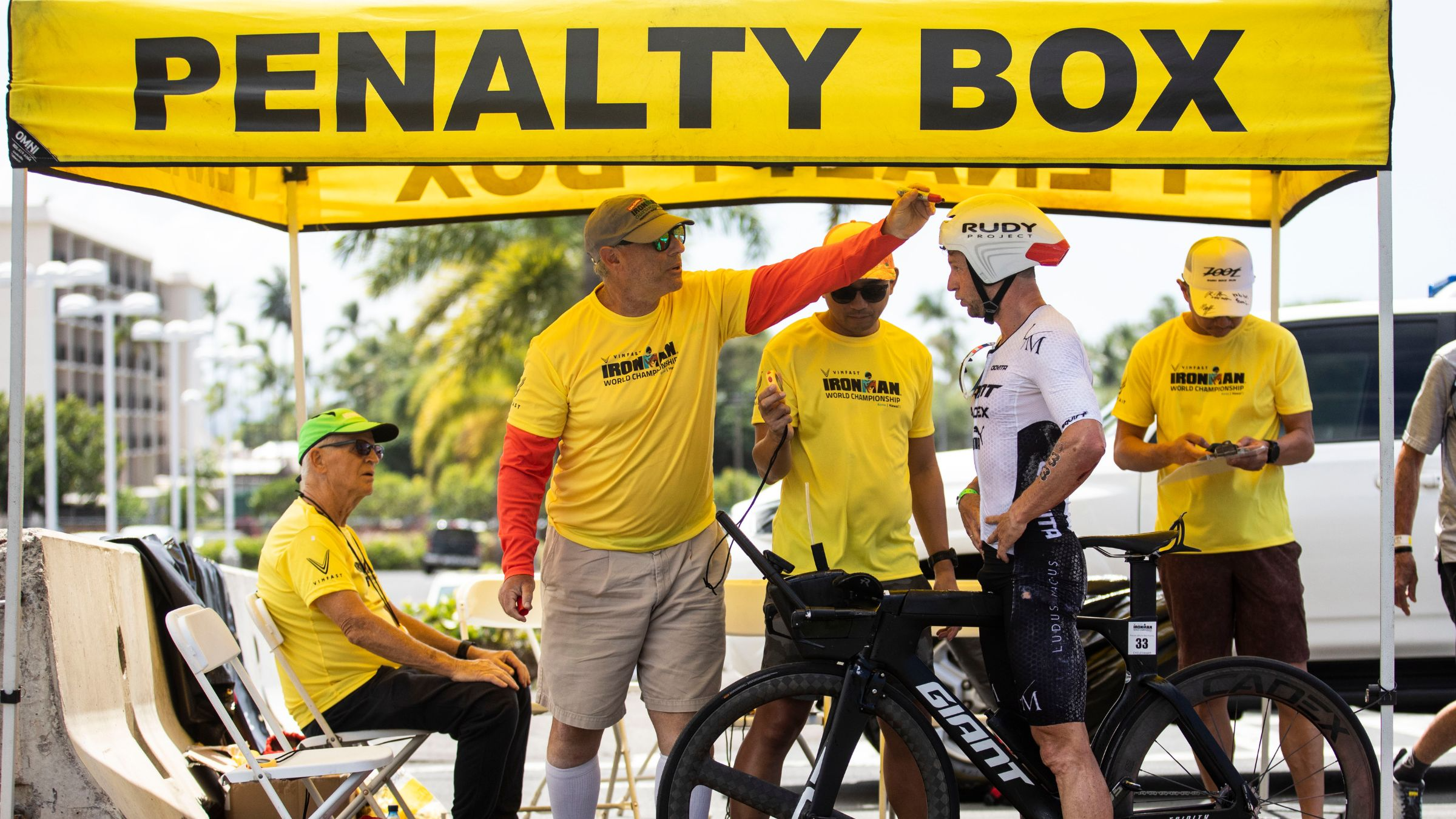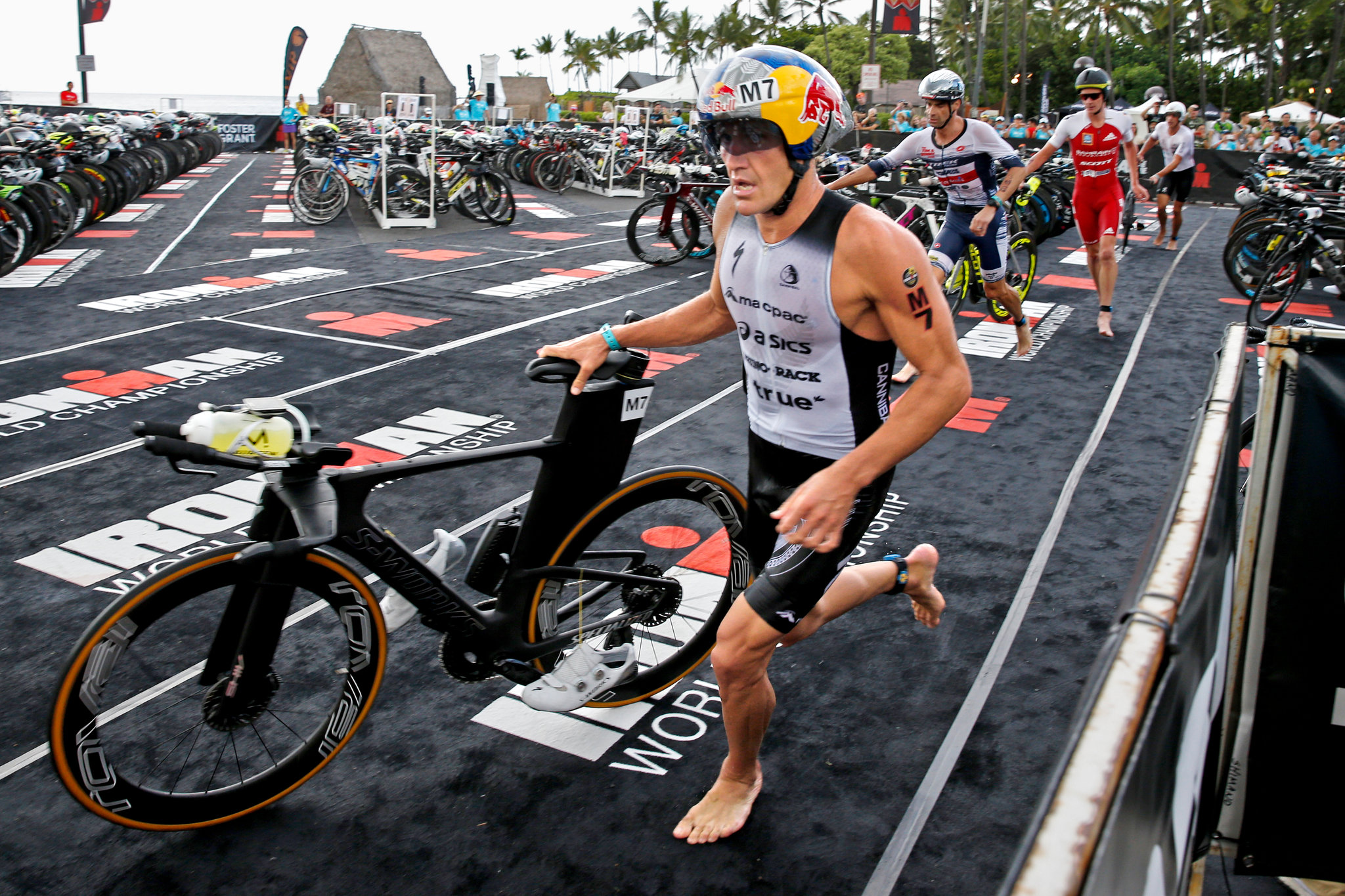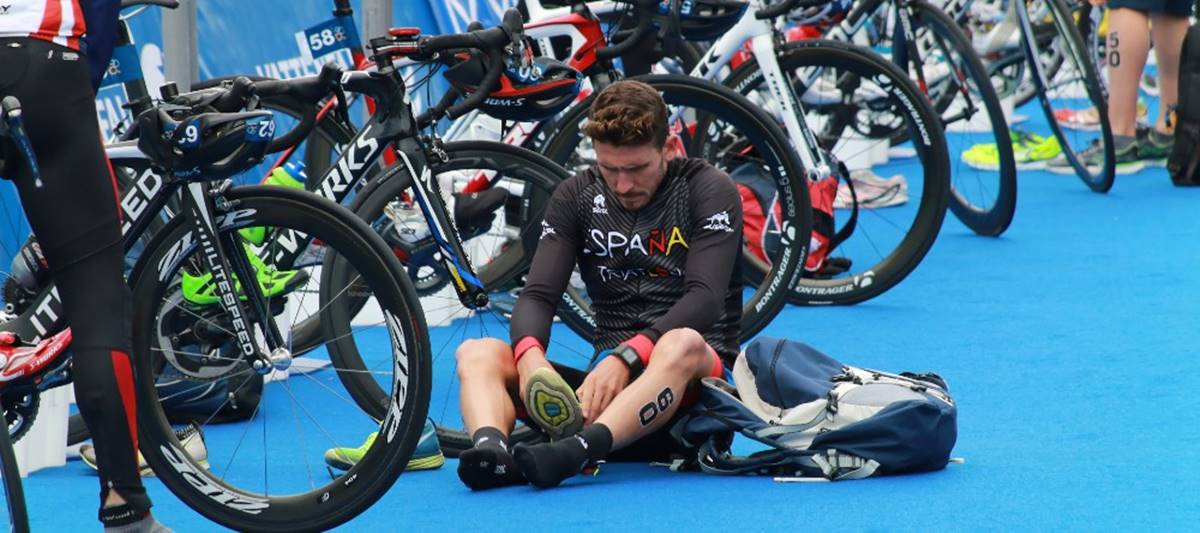

Featured
What Is The Penalty Box In A Triathlon
Published: August 12, 2023
Learn about the penalty box in a triathlon and how it affects athletes. Featured article covers rules, consequences, and strategies.
Introduction
Triathlons are thrilling and challenging multi-sport events that test athletes’ endurance and skill across swimming, cycling, and running disciplines. To ensure fair play and maintain a level playing field, triathlon races have specific rules and regulations in place. One of the key components of these rules is the penalty box, a designated area where athletes must serve penalties for any rule violations committed during the race.
The penalty box serves as a mechanism to enforce the rules and deter athletes from gaining an unfair advantage. It is a concept borrowed from other sports like ice hockey and soccer, where players are sent off the field or sin-binned for committing infractions. In a triathlon, the penalty box serves a similar purpose – to penalize athletes for rule violations while allowing them to continue in the race.
In this article, we will explore the penalty box in triathlons in more detail. We will discuss its definition, purpose, and how it works in a race. We will also highlight common offenses that can lead to a penalty and the duration athletes are required to spend in the penalty box. Additionally, we will emphasize the importance of adhering to the penalty box rules and provide strategies to avoid incurring penalties altogether.
Whether you’re a seasoned triathlete or new to the sport, understanding the ins and outs of the penalty box can enhance your racing experience and help you compete within the rules. So, let’s dive in and unravel the mystery of the penalty box in triathlons!
Definition of a Penalty Box
The penalty box is a designated area on the race course where triathletes must serve penalties for committing rule violations during a triathlon. It is a temporary holding area where athletes are required to stop, serve their penalty time, and then continue with the race.
In essence, the penalty box acts as a form of punishment for athletes who have infringed upon the rules set forth by the race organizers and governing bodies. The concept of the penalty box is inspired by other sports where players are temporarily benched for their infractions.
The penalty box in a triathlon can take different forms depending on the specific race and course layout. It may be a designated area along the race route or a marked zone at the transition area. Whatever the location, it is clearly demarcated and easily identifiable by race officials and athletes alike.
When an athlete receives a penalty during a triathlon, they are directed by race officials to serve their penalty in the designated penalty box. This ensures that the penalty is enforced swiftly and consistently across all athletes, maintaining a fair playing field.
Within the penalty box, athletes are expected to abide by certain guidelines. They must come to a complete stop, place their bike in a designated area if applicable, and serve the required penalty time. This time period varies depending on the offense committed and is typically communicated to the athlete by a race official.
Once the penalty time has elapsed, the athlete is permitted to resume the race. It is important to note that the penalty box is not intended to disqualify athletes, but rather to provide a means of penalty without removing them from the race entirely.
By having a penalty box system in place, triathlon races ensure that athletes are held accountable for their actions and deterred from gaining unfair advantages through rule violations. It promotes fair competition and upholds the integrity of the sport.
Purpose of the Penalty Box
The penalty box in a triathlon serves several important purposes in maintaining fair competition and enforcing the rules of the sport. Let’s explore the key purposes of the penalty box:
1. Enforce Fair Play: The penalty box acts as a mechanism to enforce fair play among triathlon athletes. It ensures that all participants adhere to the same set of rules and regulations, eliminating any unfair advantages gained through rule violations. By penalizing athletes in the penalty box, the race organizers and officials emphasize the importance of following the rules and competing within the set guidelines.
2. Promote Safety: Safety is a paramount concern in any triathlon event. The penalty box helps maintain a safe race environment by penalizing athletes for dangerous or reckless behavior. Offenses such as drafting on the bike leg or obstructing other competitors can lead to penalties in the penalty box. By discouraging such actions, the penalty box contributes to a safer race experience for all participants.
3. Ensure Rule Consistency: The penalty box allows for consistent application of penalties across all athletes. By providing a designated area for serving penalties, race officials can ensure that penalties are enforced uniformly and without bias. This consistency promotes a level playing field and maintains the integrity of the race.
4. Modify Behavior: The penalty box serves as a deterrent for athletes to commit rule violations. Knowing the consequence of being sent to the penalty box, athletes are incentivized to compete within the rules. It encourages athletes to be mindful of their actions and make ethical decisions during the race.
5. Preserve the Spirit of the Sport: Triathlon is not only about physical performance, but also about sportsmanship and respect for fellow competitors. The penalty box reinforces these values by penalizing athletes for unsportsmanlike conduct, such as verbal abuse or intentional rule infractions. It ensures that the sport’s spirit is upheld and that athletes compete in a respectful and honorable manner.
The penalty box in a triathlon plays a crucial role in maintaining fair play, promoting safety, ensuring rule consistency, modifying behavior, and preserving the spirit of the sport. By understanding the purpose of the penalty box, triathletes can approach the race with a sense of accountability, fairness, and respect for the rules and fellow competitors.
How does the Penalty Box work in a Triathlon?
The penalty box in a triathlon is a systematic and structured process that ensures penalties are enforced consistently and fairly. Let’s take a closer look at how the penalty box works:
1. Identification of Rule Violation: When a triathlete commits a rule violation, such as drafting, blocking, or littering, race officials or referees identify the infraction. They observe the race and ensure that all participants are adhering to the rules. Once a violation is observed, the athlete is notified that they will be required to serve a penalty.
2. Notification to Athlete: Race officials notify the athlete of their penalty through various means such as verbal communication, hand signals, or displaying a penalty card. The athlete is made aware of the infraction committed and the required penalty they need to serve. This communication is essential to maintain transparency and clarity during the race.
3. Directions to the Penalty Box: Once notified, the athlete is directed by race officials to the penalty box area. The location of the penalty box may vary, depending on the race layout and course design. It could be situated along the race route or at the transition area.
4. Serving the Penalty: Upon reaching the penalty box, the athlete must follow the specific instructions provided or the guidelines established by race officials. Typically, the athlete is required to come to a complete stop, place their bike in a designated area if applicable, and serve the required penalty time. The duration of the penalty may vary based on the nature of the violation.
5. Resume the Race: Once the penalty time has elapsed, the athlete is permitted to resume the race. They must do so in a timely manner, ensuring that they continue from the exact point where they left off. It is important for athletes to comply with the rules and guidelines outlined by officials during the process of leaving the penalty box, ensuring a seamless integration back into the race.
Throughout the process, race officials closely monitor the penalty box and ensure that penalties are enforced correctly. They maintain a record of the penalties served by each athlete to ensure fairness and consistency. Video cameras and timing systems may also be used to track the time spent in the penalty box by athletes and verify compliance.
The penalty box process is designed to maintain a fair and competitive environment for all participating triathletes. It acts as a mechanism of accountability and consequences for rule violations, encouraging athletes to compete within the established guidelines and uphold the integrity of the race.
Common Offenses and Penalty Box Duration
In a triathlon, there are various rule violations that can result in athletes being penalized and required to serve their time in the penalty box. Let’s explore some of the common offenses and the corresponding penalty durations:
1. Drafting: Drafting refers to closely following behind another cyclist, taking advantage of the reduced wind resistance. In most triathlons, drafting is not allowed except in specific circumstances. If an athlete is caught drafting, they may receive a penalty of a specific time duration in the penalty box. The penalty for drafting can range from a few seconds to several minutes, depending on the severity of the offense and the race regulations.
2. Blocking: Blocking occurs when an athlete intentionally impedes or obstructs another competitor’s progress. This can happen during the swim, bike, or run legs of the triathlon. Blocking can also involve refusing to yield the right of way or interfering with another participant’s movement. Penalties for blocking can range from a time penalty to disqualification, depending on the severity of the offense and the race rules.
3. Littering: Littering is a common offense that occurs when athletes discard any equipment or items onto the race course. This can include water bottles, energy gel wrappers, or any other debris. Littering is not only an environmental concern but also a safety hazard for other athletes. Penalties for littering can range from a time penalty to disqualification, depending on the race regulations.
4. Unsportsmanlike Conduct: Unsportsmanlike conduct includes any behavior that goes against the spirit of fair play and respect for other competitors. This can include verbal abuse, intentional rule infractions, or any action that shows a lack of sportsmanship. Penalties for unsportsmanlike conduct can vary depending on the severity of the offense, and may range from a time penalty to disqualification.
5. Course Cutting: Course cutting occurs when an athlete deliberately deviates from the designated race course, taking a shorter route. This provides an unfair advantage by bypassing certain segments of the race. Penalties for course cutting can result in a time penalty or disqualification, depending on the race regulations.
It is important to note that the penalty durations for each offense can vary depending on the specific race rules and organizers. Race officials and referees have the discretion to determine the appropriate duration of the penalty based on the severity of the offense and the impact on the race integrity.
Athletes must familiarize themselves with the race regulations and guidelines to avoid committing these offenses. By understanding the common offenses and the potential penalty durations, athletes can make informed decisions during the race and compete within the rules.
Importance of Adhering to the Penalty Box Rules
Adhering to the penalty box rules in a triathlon is of utmost importance for several key reasons. Let’s explore why it is crucial for athletes to comply with the penalty box rules:
1. Maintaining Fair Competition: The penalty box rules exist to ensure fair competition among all triathletes. By adhering to the rules and serving the required penalties, athletes contribute to a level playing field where success is determined by ability and effort rather than unfair advantages gained through rule violations. This fosters a sense of integrity and sportsmanship within the triathlon community.
2. Promoting Safety: The penalty box rules play a vital role in maintaining a safe race environment. Offenses such as drafting, blocking, or reckless behavior can pose serious risks to both the offending athlete and other participants. By serving the penalties in the penalty box, athletes are reminded of the potential dangers associated with rule violations, encouraging them to prioritize safety and the well-being of their fellow competitors.
3. Preserving Race Integrity: Adhering to the penalty box rules helps preserve the integrity of the race. Triathlons are governed by specific rules and regulations that uphold the authenticity and fairness of the event. When athletes follow the penalty box rules, they demonstrate respect for the race organizers, officials, and the sport itself. This contributes to the authenticity and reputation of the race, attracting future participants and sponsors.
4. Setting a Good Example: Athletes who follow the penalty box rules set a positive example for others to emulate. By accepting the consequences of their actions and serving their penalties, they demonstrate accountability and sportsmanship. This inspires fellow athletes to compete with honor and respect for the rules, fostering a culture of fair play within the triathlon community.
5. Minimizing Disruptions: The penalty box rules help minimize disruptions during the race. By serving the required penalties in a designated area, athletes prevent unnecessary stoppages or arguments on the course. This ensures the smooth progression of the race for all participants and allows officials to focus on the overall management and safety of the event.
Adhering to the penalty box rules is not only a matter of compliance but also a reflection of an athlete’s character and commitment to the sport. By understanding the importance of these rules and embracing a culture of fair play, athletes contribute to the overall success and reputation of triathlons, elevating the sport to new heights.
Strategies to Avoid the Penalty Box
Avoiding penalties and staying out of the penalty box is a goal for every triathlete. Here are some strategies that can help athletes navigate the race without incurring penalties:
1. Know the Rules: Thoroughly familiarize yourself with the rules and regulations specific to the triathlon you are participating in. Understand the penalties associated with common offenses and any unique rules that may apply. Being aware of the rules will significantly reduce the likelihood of inadvertently committing infractions.
2. Maintain Appropriate Distance: When it comes to drafting on the bike leg, it is crucial to maintain a safe and legal distance from the cyclist in front of you. Be mindful of the race regulations regarding drafting zones and intervals. Leave enough space between yourself and the cyclist ahead to avoid any unintentional drafting situations.
3. Practice Proper Transition Etiquette: In the transition area, ensure that you are not impeding the progress of other athletes. Keep your belongings neatly organized and avoid blocking access to other competitors’ transition spots. Practice efficient and quick transitions to avoid any unnecessary delays or conflicts.
4. Dispose of Waste Appropriately: Avoid littering on the race course by properly disposing of any wrappers, gel packets, or other waste. Be mindful of designated waste stations and use them to discard any items. If the race does not have designated waste stations, carry your waste with you until you can dispose of it properly at the appropriate locations.
5. Communicate and Be Respectful: Maintain open communication and respect with your fellow triathletes. Avoid engaging in unsportsmanlike conduct, such as verbal abuse, intentional rule infringements, or interfering with other athletes’ progress. Treat others with respect, kindness, and fairness throughout the race.
6. Stay Focused and Alert: It is crucial to stay focused on the race and remain vigilant of your surroundings. Keep an eye out for course markers, directional signs, or any instructions given by race officials. Being aware of your position and the actions of other athletes will help you make well-informed decisions and avoid infractions.
7. Seek Clarification: If you have any doubts or uncertainties about the race rules, do not hesitate to seek clarification from race officials or organizers. It is better to fully understand the regulations before the race than to face penalties due to misunderstandings or misinterpretations.
By implementing these strategies and being mindful of the rules and regulations, you can greatly reduce the risk of incurring penalties and avoid a trip to the penalty box. Remember, a clean race is not only a testament to your skill and performance but also a demonstration of your sportsmanship and respect for the sport and fellow competitors.
Conclusion
The penalty box in a triathlon serves as a crucial component in maintaining fair play, promoting safety, and enforcing the rules of the sport. It acts as a mechanism to penalize athletes for rule violations while allowing them to continue in the race. By understanding the definition, purpose, and workings of the penalty box, triathletes can compete with integrity and respect for the sport.
We explored the common offenses that can lead to penalties, such as drafting, blocking, littering, unsportsmanlike conduct, and course cutting. Each offense carries its own penalty duration, which varies based on the severity of the violation and the race regulations. By avoiding these infractions, athletes can navigate the racecourse without incurring penalties and disrupting their performance.
Adhering to the penalty box rules is of utmost importance for triathletes. It ensures fair competition, promotes safety, preserves race integrity, sets a good example, and minimizes disruptions during the race. By following these rules, athletes demonstrate respect for their fellow competitors, race officials, and the sport itself. They play a vital role in upholding the integrity and reputation of triathlons.
Furthermore, we discussed strategies to avoid the penalty box, including knowing the rules, maintaining appropriate distance, practicing proper transition etiquette, disposing of waste appropriately, staying respectful, staying focused and alert, and seeking clarification whenever necessary. By implementing these strategies, athletes can navigate the racecourse smoothly and strive for their best performance without the risk of penalties.
In conclusion, the penalty box in a triathlon serves as an integral part of ensuring fair competition, promoting safety, and enforcing the rules. Athletes must be aware of the rules, follow them diligently, and strive to compete with integrity and respect. By doing so, they not only enhance their own racing experience but also contribute to the overall growth and success of the triathlon community as a whole.









